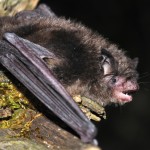Mythbusting The Misunderstood Bat
By Maria Grace, Education & Outreach Manager

Bats get a bad rap – they are blind bloodsuckers that get caught in our hair. But these are all myths and this post is going to bust them!
There are no bloodsucking bats in the U.S. Yes, there are vampire bats in the world (3 species live in the tropics from Mexico to Brazil, Chile, and Argentina) and while they do rely on blood for their sustenance, they don’t view people as a food source. They usually pierce the skin of livestock such as cows, goats or chickens, and gently lap the blood from the wound (similar to how a dog licks water from a bowl).
Bats are not blind. Most species of bats have very good eyesight but they usually depend on their sense of echolocation to navigate through the world. They emit high frequency sounds into their environment and these sounds bounce off objects and back to the bat. The bat is then able to interpret the sounds and create a picture of what their environment looks like.
Bats rarely get caught in human hair. Bats, using their sense of echolocation, can detect objects as fine as a single human hair in total darkness. They are not aggressive animals but they can fly too close to people while feeding on insects or when flying low over water to take a drink.
Beneficial bats eat bugs. Bats are incredible animals and do a lot for us. All nine species of bats found in New Jersey eat insects, consuming one-third of their weight in bugs each night. Bats play essential roles in keeping populations of night-flying insects in balance. Just one bat can catch hundreds of insects in an hour, and large colonies catch tons of insects nightly, including beetles and moths that cost American farmers and foresters billions of dollars annually, not to mention mosquitoes in our backyards.
Bats play a key role in pollination. In other areas of the world, bats are the primary pollinators for many desert plants like the saguaro and organ pipe cactus as well as many species of agave. Bats also help in the pollination of fruits and veggies like bananas, avocados, coconuts, vanilla, dates, and mangoes.
Bats also help in seed dispersal. In fact, seeds dropped by bats can account for up to 95 percent of forest regrowth on cleared land. Bats spread the seeds of almonds, cashews, and chocolate. Did you read that? CHOCOLATE! Bats help us to have more cacao trees, which produces the yummy main ingredient of our favorite Halloween treats!
So instead of screaming and freaking out if and when you see a bat, why don’t you stop and appreciate it and maybe say a little “thank you” for all the wonderful benefits they provide to us. Halloween wouldn’t be the same without bats and the delicious m&m’s, snickers, and Almond joys are made possible because of the wonderful, now better understood, bats of the world.
Discover more from Conserve Wildlife Foundation of NJ
Subscribe to get the latest posts sent to your email.